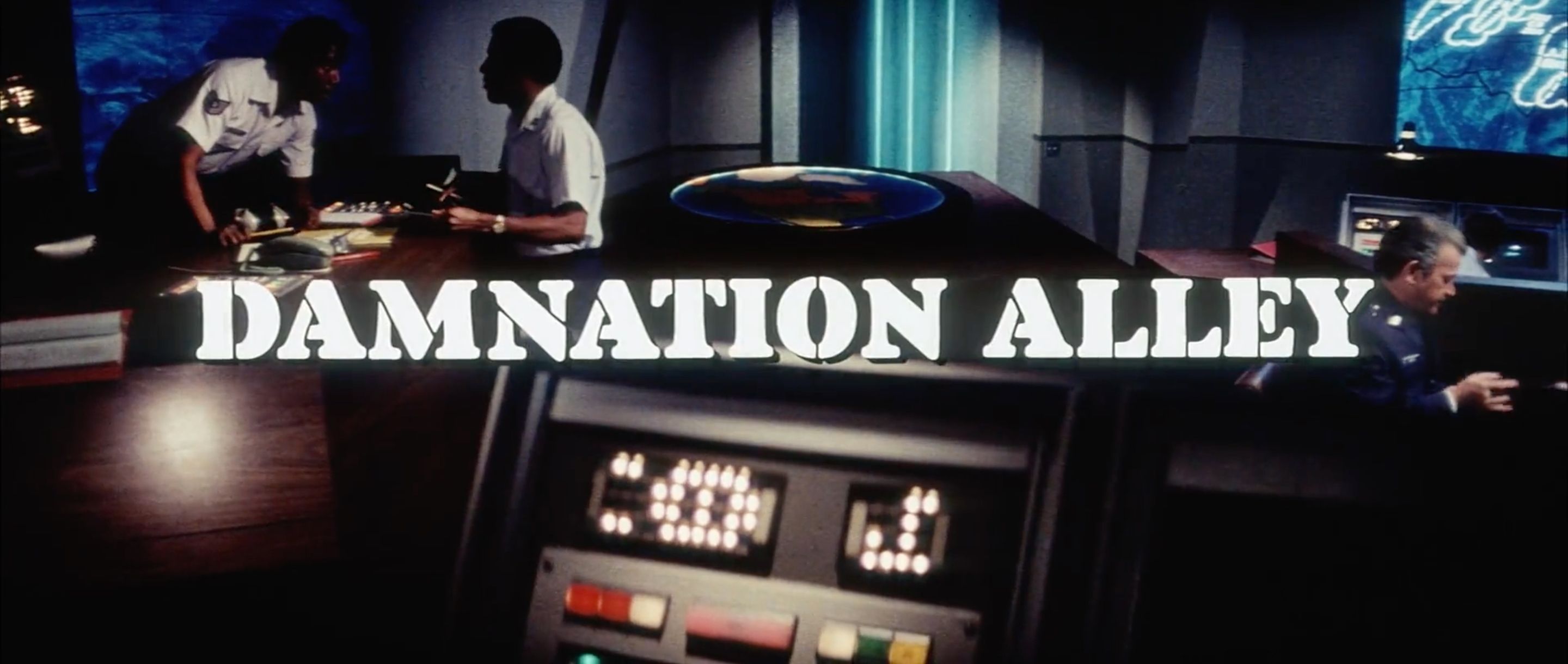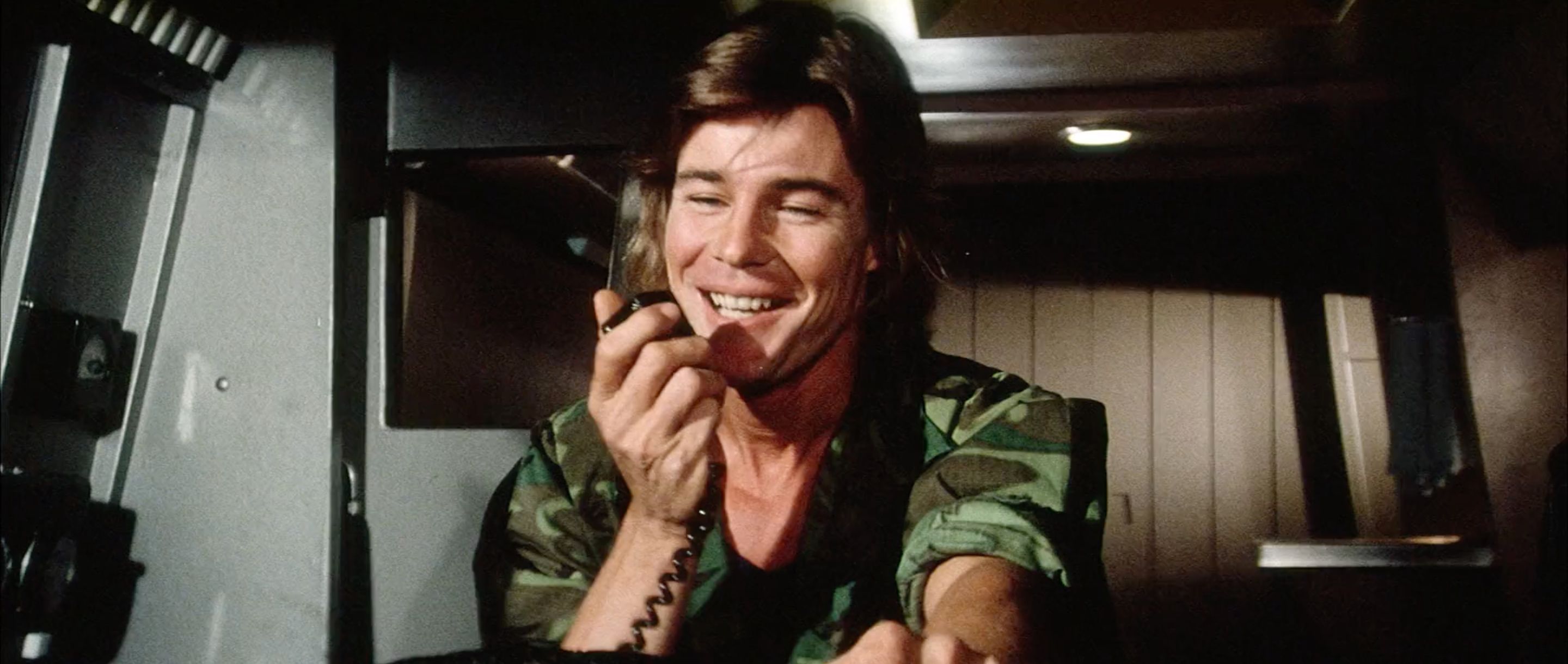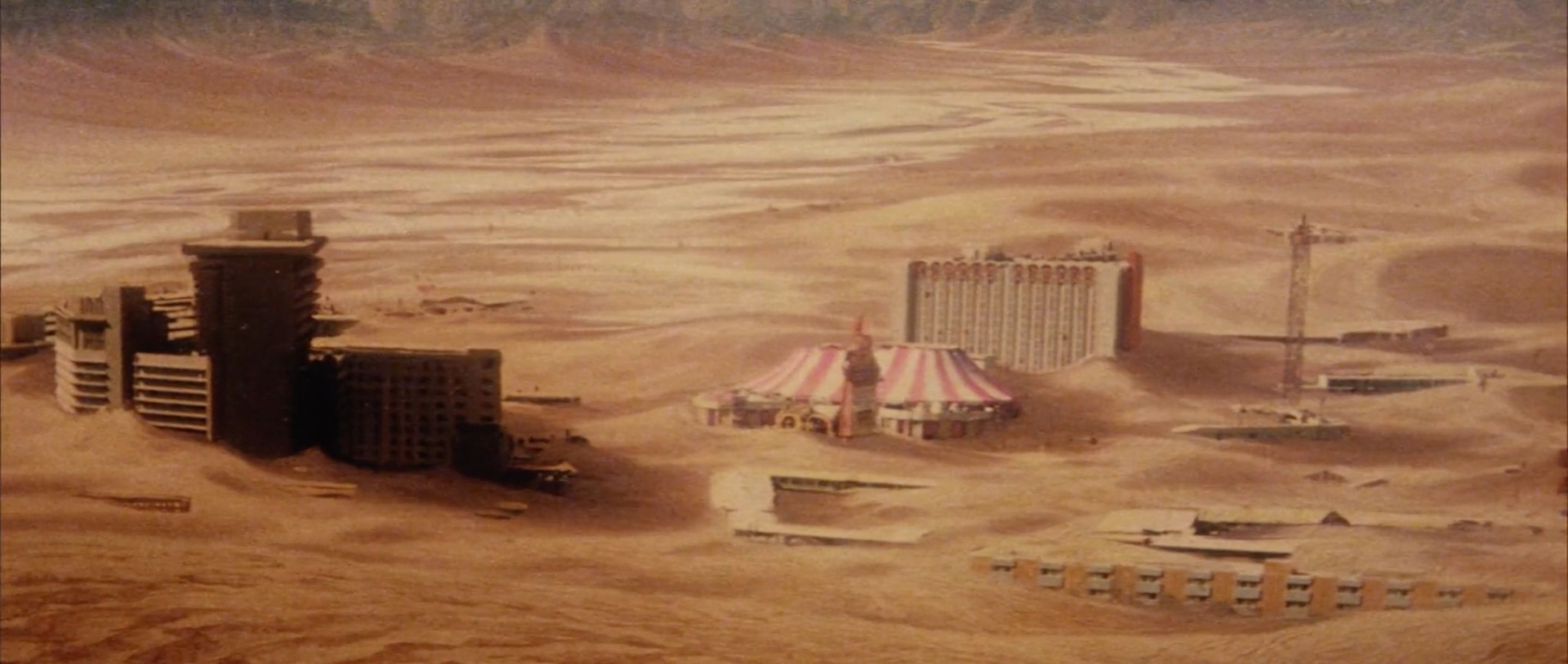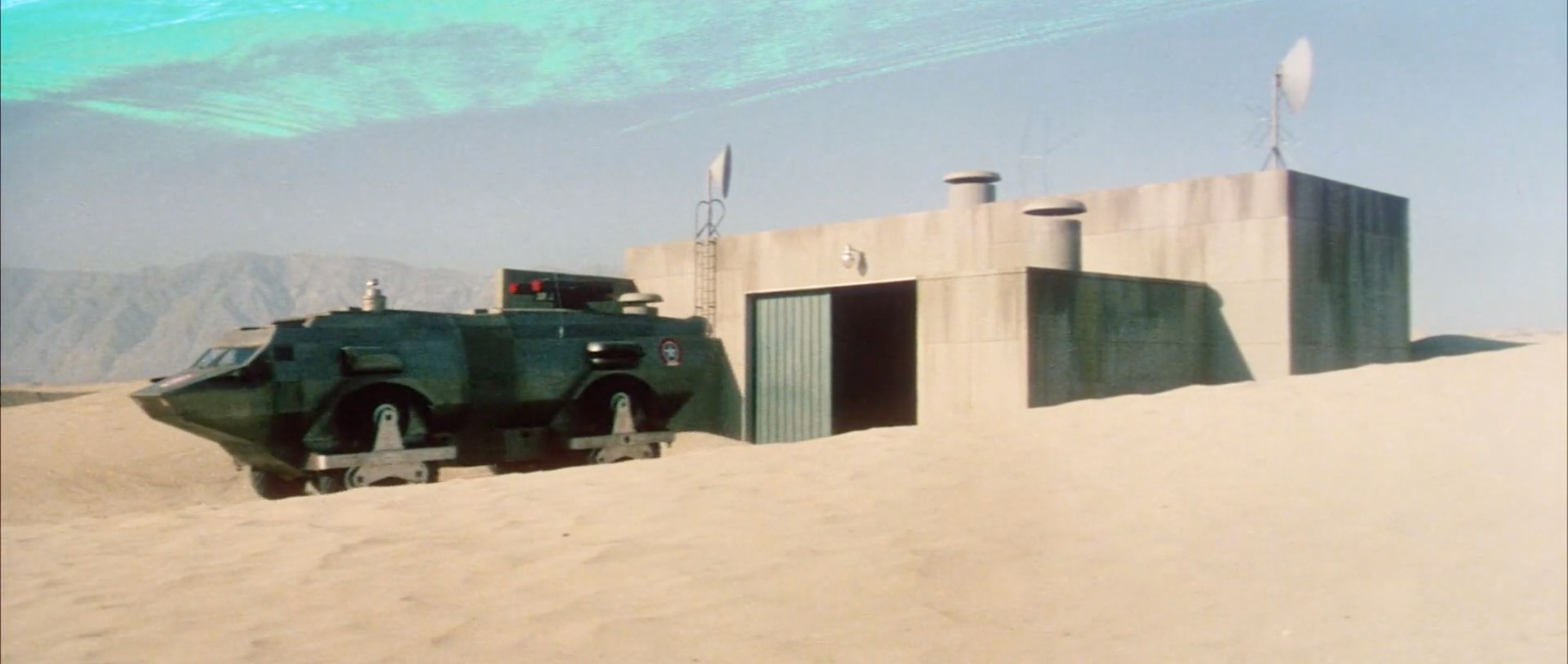 Inevitably, there are spoilers here, but I’ve tried to keep them to a minimum. Read with care. Thanks!
Inevitably, there are spoilers here, but I’ve tried to keep them to a minimum. Read with care. Thanks!
What is it? Damnation Alley, directed by Jack Smight, written by Alan Sharp and Lukas Heller (based on the novel by Roger Zelazny) and starring Jan-Michael Vincent, George Peppard, Dominique Sanda, Paul Winfield, Kip Niven, and Jackie Earle Haley. And Murray Hamilton, dammit!
First viewing? When I was little, I saw the killer cockroach scene while staying in a motel with my parents and freaked the fuck out. Not entirely sure how much, if any, I saw previous to that scene or after. I marked it as a first-time viewing on Letterboxd, so we’ll go with that.
What’s it about? After a nuclear war, the remaining soldiers of an U.S. Air Force base in California take two “Landmasters” across the devastated landscape to join a community of survivors in Albany, New York.
What are your thoughts about it? The road movie. Aloof, forbidding, terrifying. Wait, no, flip that. The road movie is one of the warmest, most inviting genre modifiers1 in cinema. You know what you’re going to get: a starting location, a destination, stops along the way, a number of relationships in a pressure cooker disguised as a vehicle that will be tested and changed. But this simple framework can filled in an unlimited number of ways. Forward momentum is encoded in the very wheels of the vehicle that’s carrying the characters to their destinies, and who knows what they’re going to find?
 “Hey good lookin’, we’ll be back to pick you up later!”
“Hey good lookin’, we’ll be back to pick you up later!”
Damnation Alley is a road movie. Alas, it’s not a good road movie. It’s exceedingly cheap looking, with very little of the handcrafted charm that mitigates an unfortunate budget. Staring at the sloppy-looking muliticolored skies and the scorpions that escaped a Bert I. Gordon movie, it’s even more egregious knowing the film cost, in 2022 money, $35 million. (Reportedly, part of the budget was redirected to another science fiction movie filming at that moment: Star Wars.) As a road movie, it takes forever to get out the starting gate. A good ten minutes are used to show WWIII starting when a intertitle would do, and even then, they don’t give the great Murray Hamilton anything to do, or literally say. The acting is serviceable, but Peppard’s accent, to my ear, keeps jumping from Southern to New England, sometimes finding some godawful in-between. And for a movie where it looks like 99% of the world’s population is dead, it’s weirdly carefree, condensing all its pathos to a moment in an empty Las Vegas casino.
 Every time I hit your crystal city, you know you’re gonna make a wreck out of me.
Every time I hit your crystal city, you know you’re gonna make a wreck out of me.
Damnation Alley isn’t good but, almost despite itself, it’s compelling. Once the Landmasters get moving, it locks on to that “what’s just around the corner?” feeling that keeps road movies interesting. And most of the encounters are fun, if sometimes dumb. (The Landmaster gets tipped over by a tornado, but floats like a bathtub toy when engulfed in a biblical flood.) The lack of any romantic drama between Vincent, Peppard and Sanda renders the film more shallow than it already is. Yet, there was no reason to expect this film to do anything interesting with it other than hit the usual beats of jealously and contrived conflict, so watching these three respect each other as human beings is refreshing. Finally, the tense encounter at the diner with the rednecks is well-done, suggesting that director Smight finally found a scene that played to his strengths. (The fact that it has almost no special effects probably helped.) Intentionally or unintentionally, some sympathy for these desperate hostage-takers leaks through; they’ve clearly been through some shit, not having a million dollar RV to bip around in, and I feel a smidgen of pity when all four are easily ganked. To borrow the tagline from the Car Wars board game, right of way goes to the biggest guns.
Now let’s talk about the bug in the room.
 Not this bug! But y not tho.
Not this bug! But y not tho.
Probably the most well known sequence is the killer mutant cockroach scene. If you’ve known me for any amount of time, you know I have a cockroach phobia. What you may not fully understand is this phobia isn’t merely a distaste for the insect; this is a full-blown debilitating mental issue2. I was not looking forward to this sequence, to say the very least. So the following may rock your world as it did mine: it’s my favorite part of the movie. Yes, it was difficult to watch. I had to pause several times, and I’ll confess I only saw about 80% of the screen, trying to focus on the humans and force all the roaches into blurry peripheral vision3. (It didn’t always work.) But just in a nuts ’n bolts way, it’s about as good as one would hope — a seemingly-anodyne situation is slowly replaced with mounting dread, then the shock of the first attack, then a flurry of action as the danger full reveals itself, and finally a hasty, nick of time exit.
 In the Cypher System, this would be a level 3 swarm. A level 3 swarm of CUTENESS.
In the Cypher System, this would be a level 3 swarm. A level 3 swarm of CUTENESS.
Let me also — I can barely believe I’m writing this — defend this sequence against the charge against it. See, due to the budget being sucked away by Star Wars, and also plain conceptual difficulty, the mass of writhing killer mutant cockroaches that menacingly creep towards our heroes… are plastic mats with fake bugs glued on them, pulled on strings. (I think maybe the put some real ones on top for verisimilitude, but I’m not going back to check.) No, this does not look realistic. But what can realism mean here? Cockroaches are just dumb bugs. They don’t hunt, and certainly not in organized packs; if anything, they scurry around semi-randomly. The concept of them doing anything menacing is ridiculous and more to the point, against nature and reality4. So what should this look like, “realistically”? If animals started doing things that were completely against their nature, shouldn’t it look and feel weird? Uncanny, even?5
How many stars out of five? Two and a half. I had every reason to not enjoy this, but I did all the same.
Where can I stream it? As of this writing6, it isn’t available to stream for free. You can rent it from Apple, Amazon, Google Play, YouTube, Vudu-Fandango, Microsoft Store, and Redbox. You can buy it from the same retailers, plus AMC Theaters On Demand.
What can we take from it? There’s little in Damnation Alley that needs a bespoke creation. Even the carnivorous cockroaches are just a swarm, and although the swarm rules in the Cypher System Revised rulebook are hard to find, they’re all there: give them a level, and only attacks that affect an area of size large or greater affects the swarm. That’s a great rule detail — you can’t start stomping on the swarm and hope to accomplish anything. They’ll crawl all over you and do damage. The roaches in Damnation Alley are level 3; extremely dangerous for “normie” NPCS, a minor challenge for PCs.
The most iconic element of the film is the Landmaster, so let’s go with that. This kind of vehicular type seemed popular in the 70s. There was the TV show Ark II (which had a very similar premise to Damnation Alley), the spaceship from TV’s Space: 1999 has a similar shape, and don’t forget the toy Big Trak. (I still have mine.) (Don’t think it works though.) And of course, the Sandcrawler from Star Wars, which I guess the Damnation Alley production paid for.
The Landmaster was created by Jeffries Automotive and cost $350,000 to create, in 1976 dollars. Today, that’d be $1.7 million. What did that buy? From what I can tell, not a whole hell of a lot. It has a special steering mechanism (it turns from the middle), but who cares? Its most distinguishing feature are the wheels. Each wheel well has three wheels, with only two touching the ground at any one time. The third wheel sits atop the other two. At the flick of a switch, the wheels can rotate, putting one of the wheels on top and rotating the third wheel so it’s touching the ground. Supposedly, this construction allows the Landmaster to drive over boulders. I don’t think we see it do any such thing in the film. (The treads of the third tires touch the other two and spin, so it doesn’t appear to save them from wear and tear.) Honestly, the whole thing smells like a way to scam a motion picture studio.
But I’ll give you a Landmaster for free! As many as you want!
 THE LANDMASTER, THREE WAYS
THE LANDMASTER, THREE WAYS
Here are three different ways to introduce the Landmaster into a Cypher System game. It could be a piece of equipment purchased by the characters; it could be an enemy vehicle that attacks the characters; or it could be a powerful artifact for the characters to find.
The Landmaster as Equipment
The Landmaster is an armored vehicle, divided into two sections, with the two sections sealed together with a thick, flexible canvas. It is 35 feet long, 12 feet high, and weighs 11 1/2 tons. It has 12 wheels, though only 8 are in use at any one time. It has a cruising speed of 60 mph, and can take a 60 degree incline as well as operate while in water. It has three separate drive sources, and can operate with either the front or rear wheels out of action. The control panel can operate a roof-mounted turret that can fire missiles. There are facilities for four passengers to exist comfortably; the more passengers added, the less comfortable it gets.
Price: Exorbitant
The Landmaster as Creature
Level: 7 (21+ on a d20 to hit it, 21+ on a d20 to avoid being hit by it)
Description: See “The Landmaster as Equipment” above.
Motive: The presumption here is that the Landmaster is being driven by an NPC and has no inherent motivation. However, another possibillty is that it has an AI installed and drives itself. In that case, let’s say it intends to take its occupants across the country safely and destroy anything in its way… not understanding that the people inside are long dead.
Environment: Typically found on blasted nuclear hellscapes, the Landmaster can be placed anywhere it could conceivably be invented.
Health: 21
Damage Inflicted: The Landmaster turret can fire missles up to a mile away, and do 7 damage in a large area. Every target takes at least one point of damage. Anyone hit by a moving Landmaster also takes 7 damage.
Armor: 4. It is effectively immune to non-Effort enhanced attacks from light and medium weapons.
Movement: Long
Modifications: No modifications.
Combat: If the driver or AI feel threatened, they will attempt to put distance between the Landmaster and the aggressors and bombard them with missiles. If neccessary, they will attempt to run over assailants, but will not go back for more (unlike, say, The Car from The Car).
Interaction: If being driven, use Interaction notes for the driver. If it’s an AI, then it interprets all outside human behavior in the worst possible way. All social tasks relating to the AI are hindered one step. However, any characters that manage to get inside the Landmaster are immediately treated by the AI as precious cargo, new passengers to be protected on its endless journey to “LBNE.”
Use: While exploring a deep canyon, the characters come across a Landmaster that has gotten hung up on an incline of boulders, because its three-drive, multi-wheel system didn’t do jack. As the characters approach, the Landmaster spins the turret towards them, and a voice intones over a speaker, “Halt and identify yourselves.”
Loot: The AI version of the Landmaster carries 1d3 cyphers or 1 artifact inside it — former property of the now-dead passengers.
GM Intrusion: The Landmaster is equipped with a self-destruct mode which it uses when its health hits 0. The explosion does 10 damage to everyone in a large area.
The Landmaster as Artifact
Level: 7
Form: See “The Landmaster as Equipment” above.
Effect: When the big red button is pushed, all doors on the Landmaster close and it begins to roll out for whatever destination the passengers agree on. It will not stop until it arrives at that destination. The Landmaster is capable of traversing a variety of difficult terrains, but will attempt to circumvent anything it deems impossible. If the button is pressed again, the Landmaster will stop; however, it may not start again (see below). The Landmaster has a missile turret, but is out of missiles.
Depletion: 1d10. When the Landmaster stops, roll for depletion. On a “1” the Landmaster runs out of fuel. Kind GMs will allow characters to find more fuel while adventuring.
NEXT TIME, ON AGAINST THE ’70S: Kiss Meets the Phantom of the Park (1978, Gordon Hessler)
Originally published 2/26/22 on Substack.
I wouldn’t consider the road movie a genre in itself, but a kind of add-on that applies to an established genre. It’s more of a structuring element, and can be applied to comedies, dramas, horror, science fiction, etc.↩︎
I will likely explore this further in a future post on Bug (1975, Jeannot Szwarc), a movie I didn’t like, was one of the most difficult viewings of my life, but one that undoubtedly belongs in the Against the ’70s canon. (2/20/24: Haven’t done this yet.)↩︎
Why do I subject myself to movies like this, if it’s such an ordeal? One of the perverse aspects of having a phobia, in my experience, is craving more information about the phobia. One thing I’d love to know is the cinematic history of cockroaches. When was the first time they appeared on screen? The earliest I know of is Luis Buñuel’s The Discreet Charm of the Bourgeoisie (1972), but if they showed up earlier, when? And if that was the first, why had they never appeared on screen earlier? (Possible earlier examples, depending on what the creatures in question actually are, include A Bay of Blood (1971), The Wages of Fear (1953) and Dracula (1932).) Anyway, I’d totally read a book about this. Just no pictures please.↩︎
We’ll see this same problem in Bug. (2/20/24: If I ever get around to it.) Surprisingly, the best killer roach movie I’ve seen in regards to this is the 1999 TV movie They Nest. (That’s They Nest, not 1988’s The Nest, which is difficult to watch for a whole host of reasons. Nor is it the 2020 drama The Nest starring Jude Law, which had all its killer roach scenes removed before release.) They Nest uses early computer graphics for a number of shots, which makes for fake, plasticky bugs, but they actually move in a threatening manner. Furthermore, there is a scene where, through the power of editing, real bugs chase a real mouse through a maze, and it’s the only time I’ve seen real roaches seem predatory. Finally, there is a well-timed shock joke that, while making me jump and a little nauseous, also made me laugh hard. They Nest: not bad!↩︎
The other explanation as to why I don’t mind these shots is that it looks so stupid and unconvincing that it allows me to relax.↩︎
2/26/22↩︎